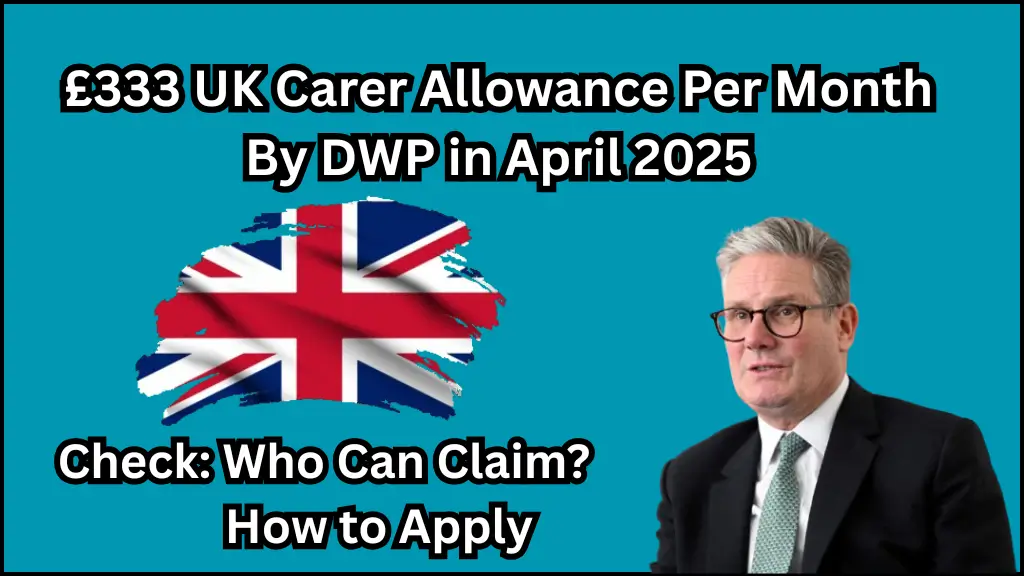UK Carer Allowance: From April 2025, the UK government is set to boost support for unpaid carers with an enhanced monthly Carer’s Allowance. Valued at approximately £333 per month, this upgrade recognizes the critical role carers play in supporting individuals with disabilities or health conditions. Below, we walk you through the essential details—including eligibility criteria, payment breakdowns, earnings limits, and a step-by-step application guide—to ensure you are fully prepared for this change.

The Importance of Carer’s Allowance
Providing care to a loved one or a vulnerable person takes immense dedication and can have significant financial implications. The revised benefit is designed to alleviate some of that pressure by offering enhanced financial support. With the new rate of £83.30 per week (resulting in around £333 monthly), carers will find it easier to manage day-to-day living expenses while continuing their essential work.
Who Can Claim?
To qualify for the Carer’s Allowance in 2025, applicants must meet several criteria:
- Age Requirement: You must be 16 years or older.
- Care Hours: A minimum of 35 hours of care per week is required.
- Earnings Cap: Your income should not exceed £196 per week after tax, National Insurance, and other allowable deductions.
- Education: Full-time education (21 hours or more per week) disqualifies the applicant.
- Geographical Eligibility: The benefit is available for residents in England, Scotland, Wales, and even abroad if serving in the Armed Forces.
Additionally, the person receiving care must be entitled to one of the qualifying benefits such as Personal Independence Payment (PIP—Daily Living Component), Disability Living Allowance (middle or highest rate for care), Attendance Allowance, Armed Forces Independence Payment, or Constant Attendance Allowance.
Payment Breakdown and Earnings Limit
Under the new arrangement:
- Weekly Payment: £83.30
- Monthly Estimate: Approximately £333
- Annual Total: Roughly £4,331.60
The government has also increased the earnings threshold to £196 per week, meaning carers who work part-time or run a small enterprise can continue to receive the allowance without immediately losing eligibility. When calculating income, deductions such as half of any pension contributions or certain care costs incurred during working hours are taken into account.
How to Apply
The application process has been simplified to help ensure a smoother experience:
- Prepare Your Details:
Gather your National Insurance number, recent payslips or self-employment records, and your bank details. - Collect Information About the Person You Care For:
Have their benefit details handy, as these are necessary for the application. - Submit Your Application:
Visit the official Carer’s Allowance page on gov.uk to complete your application online. Paper forms are available upon request if you prefer. - Processing Time:
Applications are processed within approximately three weeks, with potential backdating of up to three months from the submission date if approved.
Being diligent with your weekly care records and promptly informing any changes in income or personal circumstances can speed up your claim and ensure you retain eligibility for additional benefits such as National Insurance credits.
Frequently Asked Questions
Q1: Who is eligible to claim the updated Carer’s Allowance?
A: Applicants must be aged 16 or over, provide at least 35 hours of care per week, earn no more than £196 after deductions, and not be enrolled in full-time education. The care recipient must also be receiving one of the qualifying benefits.
Q2: Can I claim Carer’s Allowance if I live with the person I care for?
A: Yes, living with the individual does not affect eligibility as long as the care and other criteria are met.
Q3: What happens if more than one person provides care?
A: Only one carer can claim the allowance for each individual being cared for, so it’s important to designate a primary carer.
Q4: Is the Carer’s Allowance taxable?
A: Yes, the allowance is considered taxable income. If your total income exceeds your personal allowance, you may be liable for tax.
Q5: How can I avoid losing my benefit if my earnings increase?
A: By keeping detailed records and consulting with a benefits adviser, you can ensure your earnings remain within the permitted threshold and avoid any penalties.
Admin at Sirfal.com – Experienced blogger since 2015, sharing Q&A content and latest job updates.